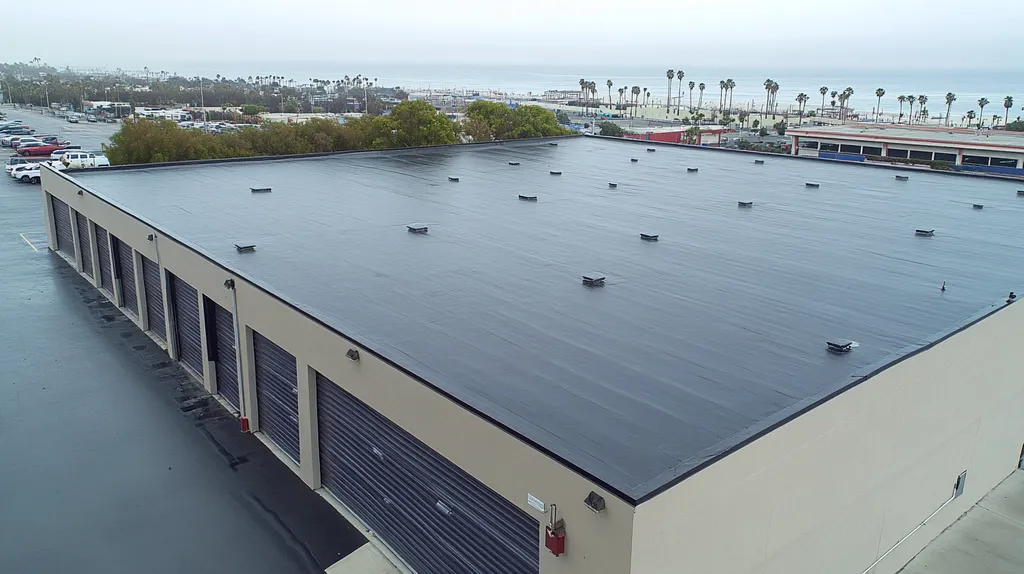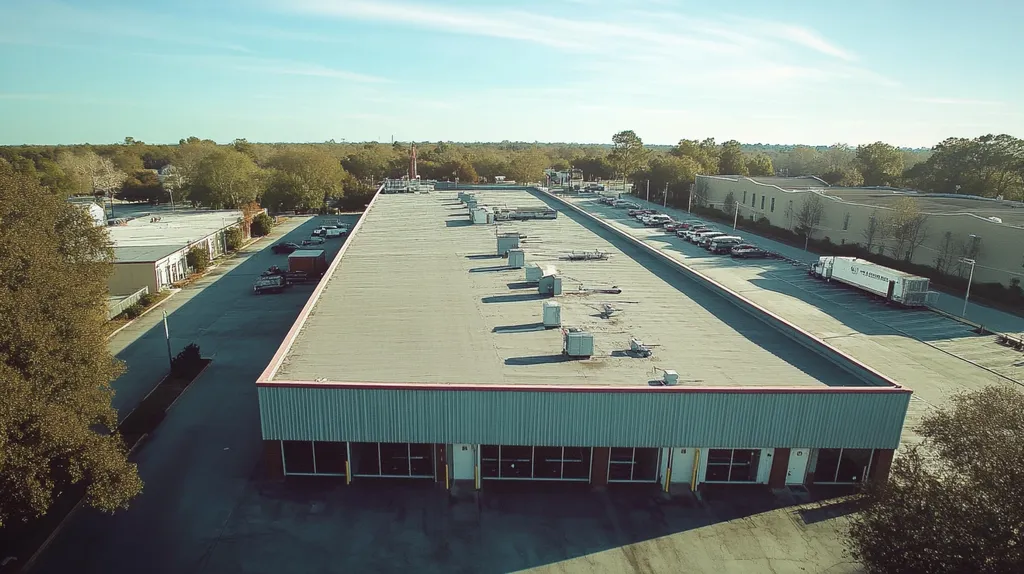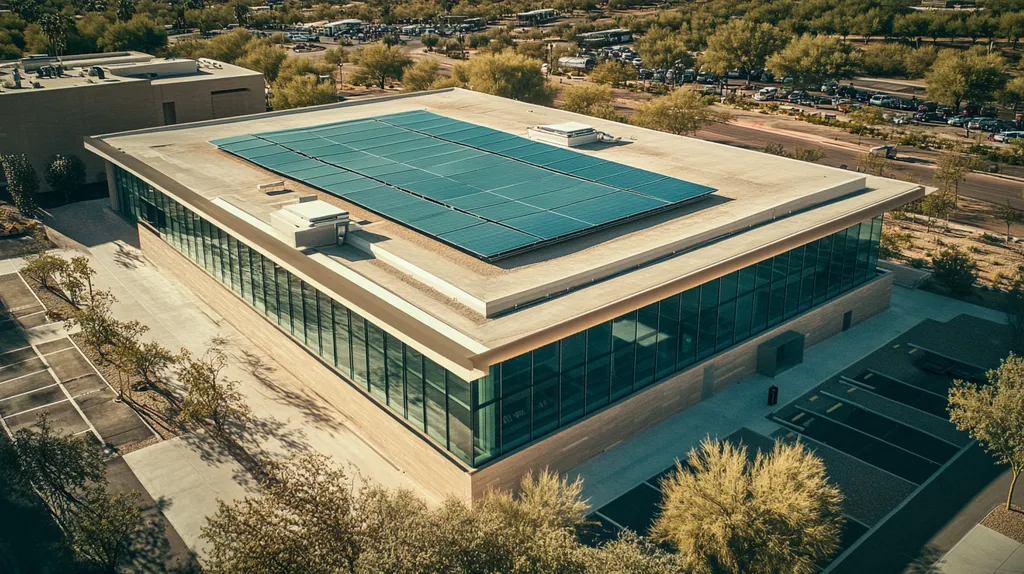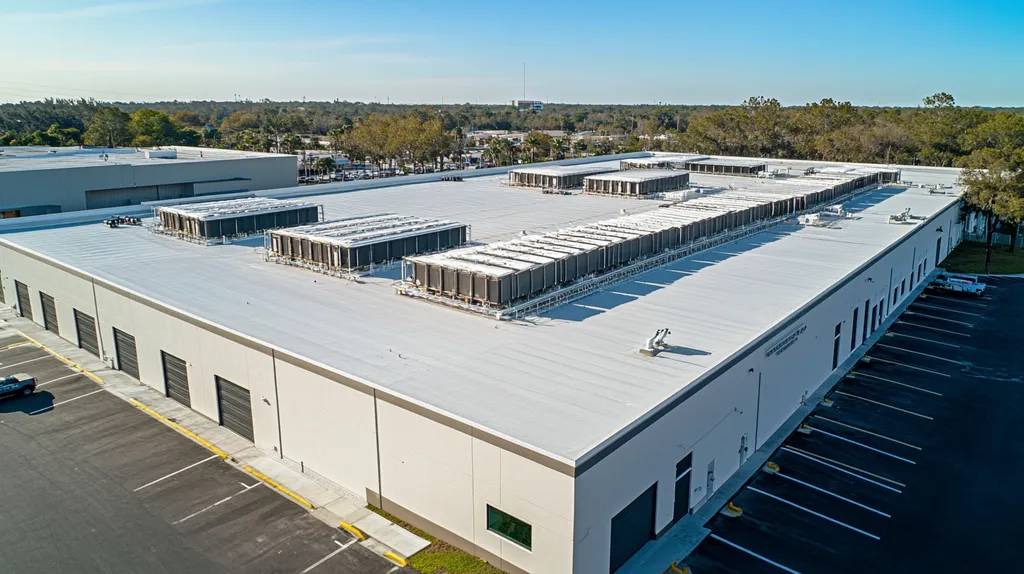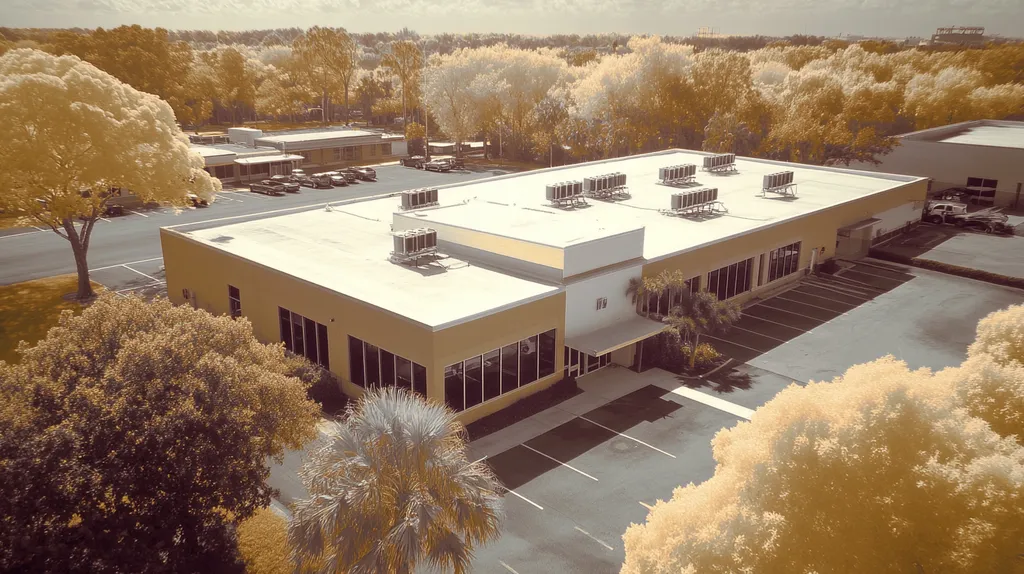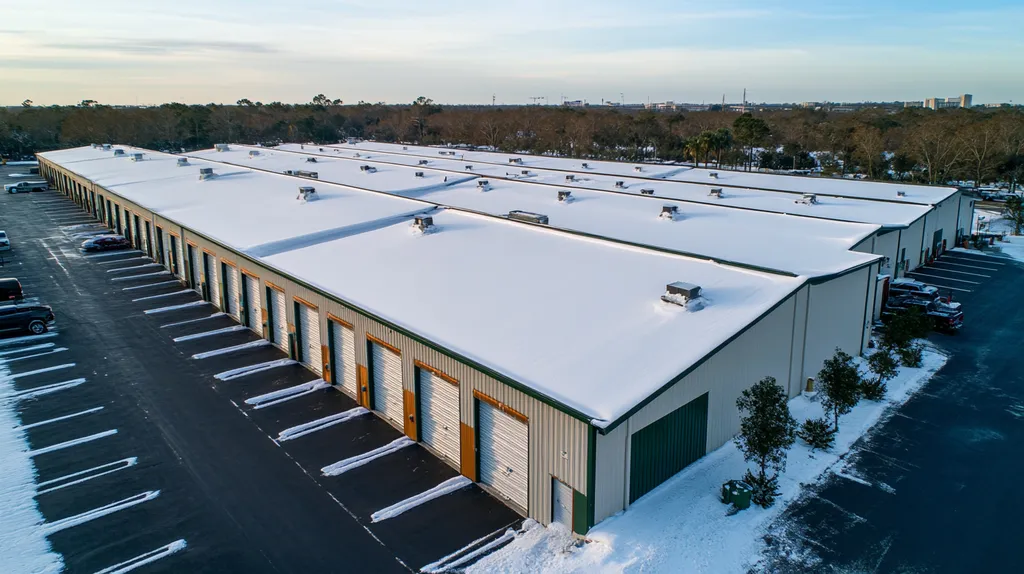In commercial roofing, proper coating application can mean the difference between a roof lasting 20+ years or failing prematurely within 5-7 years. With replacement costs averaging $7-15 per square foot, stakes are extraordinarily high for property owners and facility managers.
The science and methodology behind roof coating application have evolved dramatically, introducing sophisticated materials and techniques that can extend roof life by up to 75% when properly implemented.
This comprehensive guide examines the critical elements of successful coating applications, from surface preparation to final curing, equipping property managers with the knowledge to make informed decisions about their roofing investments.
SECTION 1: THE BASICS EXPLAINED
Understanding roofing coatings is essential for commercial property owners, particularly given that roofs can account for nearly 10% of a building’s replacement cost. Lackluster coatings can lead to premature roof failure, causing significant financial strain and operational disruptions. This section will break down what roof coatings are, why they are vital for your building’s longevity, and how they protect and enhance roofing systems.
What It Is (In Plain Language)
Roof coatings are specialized materials applied directly to the roof’s surface, forming a robust protective layer. Comprised of materials like acrylics, silicones, polyurethanes, and PMMA, these coatings act as a barrier against harsh environmental elements such as UV rays, moisture, and extreme temperature fluctuations.
By opting for a roof coating, property owners can revitalize existing roofing systems without incurring the steep costs associated with complete replacement. This cost-effective strategy not only extends the roof’s lifespan but also boosts energy efficiency—a smart choice for any budget-conscious owner.
Additionally, coatings can be applied to a variety of roofing types, including metal, single-ply, and built-up systems. Selecting the right coating requires understanding the unique needs of each roofing system, ensuring maximum protection.
Mastering the proper application techniques is crucial for achieving the desired durability and performance from the coatings. Empowering property managers with this knowledge helps them make informed decisions about their roofing investments.
Why It Matters (To Your Building)
The integrity and efficiency of commercial roofs are directly influenced by roof coatings. A carefully selected and correctly applied coating can lead to substantial reductions in maintenance costs. Many buildings suffer from leaks and other complications due to insufficient roof protection.
Investing in high-quality coatings can prevent the financial burden of frequent repairs and early replacements. Research shows that coated roofs typically outlast their uncoated counterparts by several years.
Moreover, these coatings often have reflective properties that minimize heat absorption, effectively lowering energy costs. As energy bills continue to rise, such savings are becoming increasingly crucial for property managers.
Ultimately, effectively utilizing roof coatings helps businesses maintain the value and functionality of their facilities, promoting smoother and more efficient operations.
How It Works
Roof coatings work by creating a strong bond with the roof surface, leading to a seamless barrier that effectively seals potential leak points. This essential protective layer not only prevents water intrusion but also guards against wear and tear caused by weather-related factors.
As the coatings cure, they solidify and enhance the roof’s resilience against impacts and abrasions. Many coatings also provide robust UV protection that minimizes the risk of thermal deformation over time.
The reflective capabilities of certain coatings are crucial for efficient energy management. By bouncing sunlight away from the roof, they help maintain a cooler indoor environment, which can significantly reduce cooling costs.
By grasping the mechanics behind how coatings work, property owners can make strategic decisions regarding their roof maintenance and select products that address their building’s specific requirements.
SECTION 2: PRACTICAL APPLICATIONS
Understanding the practical applications of roof coatings is essential for maximizing the longevity and efficiency of commercial roofs. Specific coatings can significantly enhance performance, providing crucial protection against damaging UV rays, leaks, and thermal stress. In fact, roofing systems with coatings can reduce energy consumption by up to 30%, translating into substantial savings over time. This section will explore common uses and scenarios for applying coatings, the most urgent moments for intervention, and how coatings effectively interact with other roofing systems.
Common Uses & Examples
Roof coatings perform a variety of critical functions, transforming the durability and efficiency of commercial roofs. For example, reflective coatings are widely used on flat roofs, minimizing heat absorption and significantly lowering cooling costs. Waterproof coatings are particularly vital in regions that experience heavy rain or snowfall, offering an effective barrier against leaks.
In industrial environments like manufacturing plants or warehouses, elastomeric coatings are favored for their flexibility and ability to bridge cracks. Educational institutions and healthcare facilities often choose these coatings due to their ease of maintenance and contribution to improved indoor air quality. Additionally, utilizing roof coatings in industrial settings can help meet important safety compliance standards.
When You Need It Most
The urgency to apply roof coatings typically arises during specific pivotal moments. For instance, if a roofing system approaches its warranty expiration, it presents an ideal opportunity for a protective coating. This proactive step can extend the roof’s lifespan considerably, preventing costly replacements.
Moreover, if a building suffers from recurrent leaks or weather-related damage, applying a roof coating can provide immediate relief and long-lasting protection. Property owners should also consider installing coatings during routine maintenance to boost performance and stave off future complications.
Interactions With Other Systems
It’s crucial to understand how coatings interact with other roofing systems to ensure optimal performance. Compatibility between the coating and the underlying membrane is essential to avoid degradation. Some coatings require specific primers to guarantee a successful bond, while others can be applied directly to the surface.
Additionally, roof coatings can significantly enhance insulation effectiveness by reducing thermal bridging. This complementary relationship boosts overall energy efficiency within the roofing system. Property owners must be mindful of these interactions to achieve the best return on their investment in roof coatings.
SECTION 3: KEY TERMINOLOGY DECODED
Grasping the terminology associated with roof coatings is critical for commercial property owners and facility managers. Misunderstandings can lead to flawed decisions and unexpected expenses. Key terms like “reflectivity” and “mil thickness” significantly impact both the application process and the overall performance of the roof. This section will simplify these essential terms, allowing for better-informed choices in roof coating projects.
Essential Terms Explained
Reflectivity is the measure of a roof coating’s ability to bounce back sunlight and heat. A higher reflectivity can lower cooling costs, making this a vital consideration for enhancing energy efficiency. With reflective coatings, surface temperatures can drop significantly, leading to an extended roof lifespan and shrinking energy bills.
Mil thickness represents how deep the coating is, with one mil equalling one-thousandth of an inch. This thickness plays a crucial role in durability and generates meaningful protection against environmental elements. Coatings that are too thin may fail to provide adequate coverage, leading to early wear and damage.
Elongation is another term that describes a coating’s flexibility to stretch. A coating with high elongation can expand and contract with temperature fluctuations without developing cracks. This characteristic is particularly important in climates that experience severe temperature changes.
Familiarity with these fundamental terms empowers property owners to critically evaluate their options and select the most effective products for enduring performance.
Industry Jargon Translated
Industry jargon can often create confusion. For instance, “UVA” and “UVB” refer to distinct spectra of ultraviolet light that affect roof coatings. Coatings designed to withstand both UVA and UVB rays will enjoy a longer lifespan, protecting the roof from sun damage.
“Substrate” denotes the surface to which the coating is applied. Proper preparation of the substrate is essential for effective adhesion and long-term results. Recognizing different substrate types—such as metal, concrete, or single-ply membrane—affects the choice of coatings required.
Translating this jargon into actionable insights ensures that conversations around roof coatings remain focused and productive, ultimately fostering enhanced decision-making.
Measurement & Units Simplified
Accurate measurements are critical when specifying roof coatings. Terms like “square footage” refer to the area that will be coated, and getting this calculation right is key to determining how much product is needed—too much or too little can lead to wasted resources or underperformance.
“Solids content” is another critical factor, indicating how much coating will stick once applied. A higher solids content results in better coverage, translating to fewer reapplications and reduced maintenance costs. Understanding this metric is essential for assessing product effectiveness.
When discussing warranties, it’s vital to know the distinction between “substrate warranty” and “coatings warranty.” The substrate warranty covers the base material, while the coatings warranty specifically pertains to the protective layer added. Clarity in these terms is crucial for safeguarding long-term investments.
By mastering these measurements and units, property owners can ensure that their roofing decisions are based on solid data, leading to enhanced performance and cost savings.
SECTION 4: DECISION FACTORS
Deciding on roof coatings is a high-stakes endeavor that can dramatically impact the longevity, functionality, and financial health of commercial buildings. Studies reveal that improper coatings can slash a roof’s lifespan by up to 50%, making it essential for property owners to consider key factors before making a commitment. Cost, performance, and durability are intertwined elements that inform these decisions. A careful assessment of each factor can empower facility managers to choose the optimal solution tailored to their unique roofing needs.
Cost Considerations
Cost remains a pivotal concern for property owners, and while coatings can seem like a budget-friendly option initially, the long-term picture often tells a different story. Cheaper coatings may lead to inconvenient repairs and premature replacements, ultimately inflating total expenses.
Investing in high-quality coatings may feel daunting at first, but this expense pays off over time. For example, a premium coating might have a higher upfront price but typically provides an extended lifespan and requires less maintenance. This investment is more than justified by the savings on future repair costs.
Conducting a life-cycle cost analysis before committing is essential. This approach helps property owners account for both immediate and future expenses, ensuring they select a roofing solution that aligns with their budget while delivering optimal performance.
Additionally, owners should evaluate available warranties. Many reputable coatings come with strong warranties that can significantly alleviate financial risks, offering valuable peace of mind and protection for their investments.
Performance Trade-offs
Assessing performance is crucial when selecting a roof coating, as different options present a mix of advantages and potential limitations. Certain coatings may excel in energy efficiency or moisture resistance, but property owners need to understand their specific weaknesses as well.
For example, while reflective coatings enhance energy efficiency by reducing cooling costs, they may not endure high foot traffic areas well. Ensuring that a coating’s performance aligns with the building’s environmental conditions is vital for effective decision-making.
Some coatings boast rapid curing times, allowing for quick application without major disruptions. However, these ‘fast cure’ coatings may not always provide the same durability as those requiring longer curing times. Striking the right balance between speed and performance is a key consideration for maintaining a building’s long-term functionality.
Evaluating coating specifications is essential for ensuring a strong match between performance capabilities and building needs, enabling property owners to make informed choices that optimize their roofing investments.
Lifespan & Durability Factors
Lifespan and durability profoundly influence the long-term value of roof coatings. Options with extended life expectancies contribute to lower life-cycle costs, making them a wise investment. Generally, high-quality coatings can last up to 15 years or more with appropriate maintenance.
Choosing a durable coating enhances resistance against UV rays, severe weather, and daily wear and tear. This fortification minimizes the risk of leaks and failures, which can result in costly damages over time.
Local climate conditions are also critical when predicting a coating’s lifespan. For instance, regions with extreme temperatures or high humidity require coatings specifically engineered to handle such stresses. Ensuring the selected coating is suited to its environment guarantees optimal performance.
Finally, routine inspections and proactive maintenance significantly extend the lifespan of any roof coating. By actively managing their roofing investments, property owners can enhance durability and reduce the likelihood of future repair costs, preserving the value of their facilities.
SECTION 5: COMMON CHALLENGES
Applying roof coatings in commercial environments might appear straightforward, but numerous pitfalls can negatively affect the roof’s longevity and performance. Research indicates that improperly applied coatings can shorten a roof’s lifespan by up to 40%. Understanding common challenges, recognizing warning signs, and implementing preventive strategies is crucial for saving properties from costly repairs and enhancing roof life.
Frequent Problems & Solutions
A key challenge faced by property owners is inadequate surface preparation prior to applying roof coatings. Rushing this vital step can lead to poor adhesion, drastically undermining the coating’s effectiveness.
To avoid this pitfall, property owners should invest in thorough cleaning and surface evaluations. Techniques like power washing and debris removal are essential before any application process begins.
Additionally, addressing existing issues such as corrosion or blistering beforehand is crucial. Tackling these problems not only enhances the integrity of the new coating but also ensures a longer-lasting protective layer.
Selecting the correct coating for the specific roof substrate cannot be overstated. Mismatched coatings often lead to premature failures, so conducting careful research and consulting with roofing professionals is strongly recommended.
Warning Signs To Watch For
Early detection of warning signs can prevent minor issues from evolving into major roofing failures. Observing discoloration, chalking, or peeling of the coating can point to deterioration.
Moreover, moisture accumulation, particularly in seams or corners, indicates potential failures lurking beneath the surface. Prompt action in response to these issues is critical to prevent water infiltration.
The appearance of blisters or bubbles under the coating is another telltale sign that should not be overlooked. These often hint at trapped moisture or insufficient adhesion and require professional evaluation right away.
Engaging in regular inspections after a coating application is invaluable for identifying such problems early. Timely interventions can lead to significant cost savings in repairs.
Preventative Approaches
Implementing preventative maintenance is essential for prolonging a commercial roof’s service life. Routine inspections help spot potential problems before they become critical. This proactive management allows for timely maintenance, avoiding costly emergencies.
Establishing a regular cleaning schedule is vital in mitigating debris buildup that can undermine roof integrity. Facilities managers should integrate this into their annual maintenance plans.
Investing in high-quality, durable coatings tailored to the specific roofing material can greatly limit future weathering and environmental stress-related issues.
Lastly, training staff regarding basic roofing care fosters awareness among the team. An informed workforce is crucial for noticing and reporting small issues before they escalate into larger, costly problems.
SECTION 6: NEXT STEPS & RESOURCES
In a landscape where roof replacements are increasingly costly and leaks can jeopardize valuable assets, making timely decisions about roof coatings is crucial. A properly applied roof coating can not only significantly extend the life of a roof but also enhance energy efficiency. To navigate this complex process successfully, property owners and facility managers must arm themselves with the right questions, understand industry standards, and tap into resources available for ongoing education.
Questions To Ask Providers
When choosing a roofing contractor to apply coatings, property owners should prioritize certain inquiries to ensure quality execution. Start by asking about the specific manufacturer of the coating and whether the contractor is an approved applicator. This detail is crucial, as it affects both warranty validity and the overall performance of the coating.
Additionally, it’s important to understand the preparation process prior to application. Effective adhesion relies heavily on surface cleanliness, so contractors should be able to describe how they will clean and prime the roof before applying the coating.
Finally, discuss the safety and environmental impact of the materials used. Knowing the components of the coatings can help ensure compliance with local regulations and contribute to broader sustainability efforts, making it a responsible choice for property management.
Industry Standards & Guidelines
Adhering to industry standards is essential for ensuring effective roof coatings. The American Society for Testing and Materials (ASTM) provides guidelines that assist property managers in evaluating coating products. For instance, coatings should meet ASTM D6083 standards for water-based acrylic roof coatings, ensuring reliability and performance.
Furthermore, the National Roofing Contractors Association (NRCA) offers invaluable resources detailing best practices for surface preparation and application techniques. Aligning with these guidelines helps prevent premature failures and any compliance-related issues.
Property owners should also stay informed about local building codes, which may impose specific requirements on roof coatings, especially regarding energy-efficient reflective properties. Compliance not only supports regulatory measures but also results in long-term cost savings.
Further Learning Simplified
Continuing education is vital for property owners and facility managers who want to deepen their understanding of roof coatings. Resources like industry webinars, workshops, and certification programs provide valuable insights into the latest materials and application techniques.
Many online platforms host courses covering topics from the fundamental principles of roof coatings to advanced troubleshooting strategies. Exploring these offerings can enhance decision-making abilities and provide a competitive edge in property management.
Additionally, subscribing to industry publications and newsletters can keep property professionals informed about emerging trends and innovations. Regular updates can ensure that they remain equipped with the latest tips and best practices for maintaining and optimizing their commercial roofing systems.
The Bottom Line
With commercial roof replacement costs soaring to $15 per square foot, proper coating application represents a critical investment in building longevity and performance.
The science behind modern coating systems offers unprecedented opportunities to extend roof life by up to 75% while delivering substantial energy savings through enhanced reflectivity and thermal management.
Success hinges on selecting appropriate materials, ensuring meticulous surface preparation, and partnering with qualified contractors who understand the nuances of different coating systems.
As building technologies evolve and environmental pressures mount, roof coatings will play an increasingly vital role in protecting commercial assets and supporting sustainability goals.
The future of commercial roofing lies in these sophisticated coating solutions, making educated implementation essential for property owners and facility managers.
FREQUENTLY ASKED QUESTIONS
Q. What are commercial roof coatings and why are they important?
A. Roof coatings are materials applied to roofs to extend their life and enhance performance. These coatings protect against environmental elements and can save on costly replacements. Investing in high-quality coatings also boosts energy efficiency, making it a wise financial decision for property owners.
Q. When should I apply coatings to my commercial roof?
A. You should apply coatings when nearing warranty expiration or experiencing leaks. Using coatings at these critical moments can significantly extend the roof’s lifespan and provide immediate protection against water intrusion. Regular maintenance and inspections also help identify the right timing for application.
Q. What does “reflectivity” mean in commercial roofing terms?
A. Reflectivity measures a roof coating’s ability to bounce back sunlight and heat. Higher reflectivity helps lower cooling costs, extending the roof’s lifespan while reducing energy bills. Understanding reflectivity is essential when choosing the best product for your specific commercial roof needs.
Q. How can I assess the quality of roof coatings?
A. Evaluate roof coatings by considering cost, performance, and durability. Higher initial costs for premium coatings often lead to lower life-cycle costs due to decreased maintenance. Additionally, reviewing warranties can provide insights into the expected performance and longevity of the product.
Q. What are some common challenges when applying coatings on commercial roofs?
A. Common challenges include inadequate surface preparation, which can lead to poor adhesion. Property owners must ensure surfaces are clean and free from existing damage before application. Additionally, mismatched coatings and environmental conditions can also negatively affect results, so careful planning is essential.
Q. What questions should I ask roofing contractors about coatings?
A. Inquire about the coating manufacturer and whether the contractor is an approved applicator. Additionally, ask about their surface preparation methods and the environmental impact of the materials used. These questions are crucial for ensuring quality application and maintaining warranty coverage on your investment.
Q. How can I maintain my industrial roof coatings for longevity?
A. To maintain industrial roof coatings, conduct regular inspections and cleanings to prevent debris buildup. Address minor issues promptly and follow a routine maintenance schedule. By actively managing coatings, property owners can enhance durability and reduce the likelihood of costly repair needs down the line.

